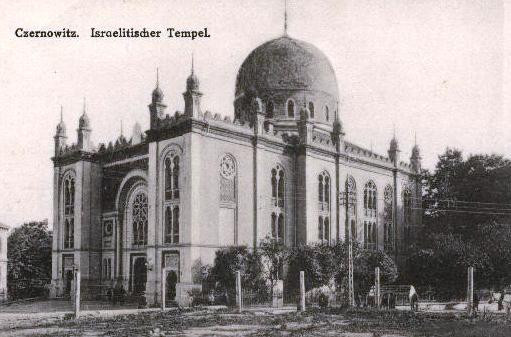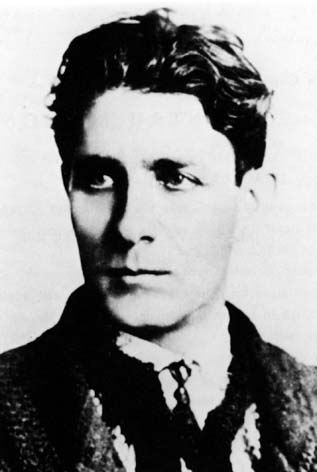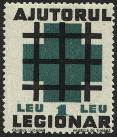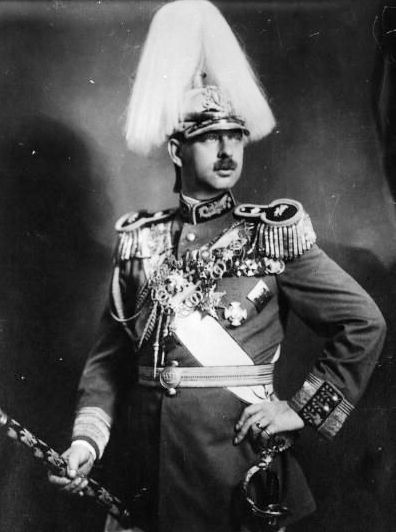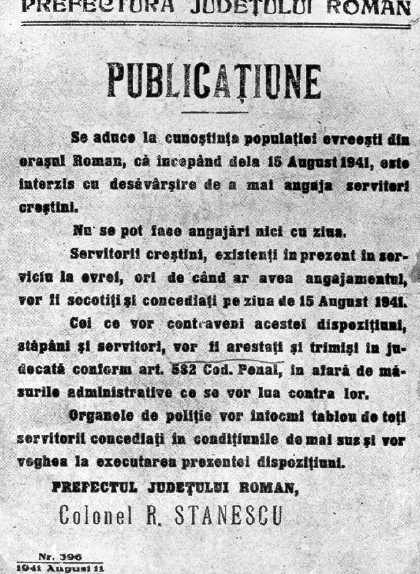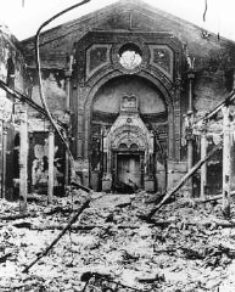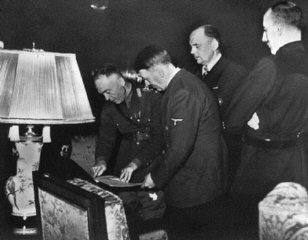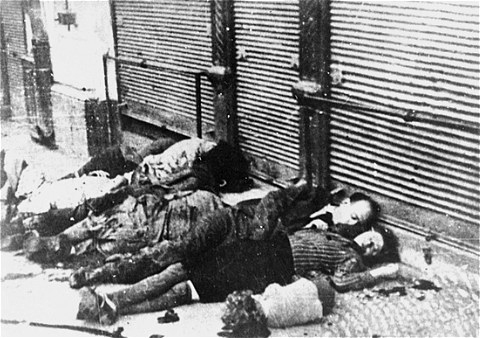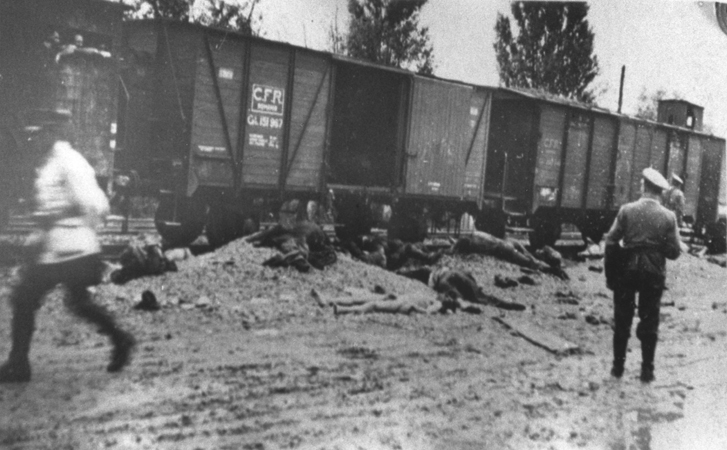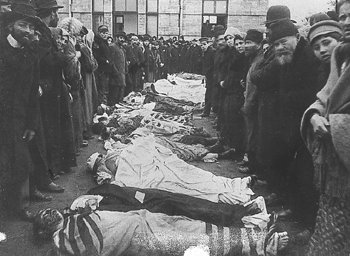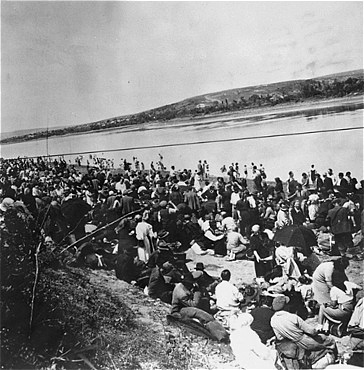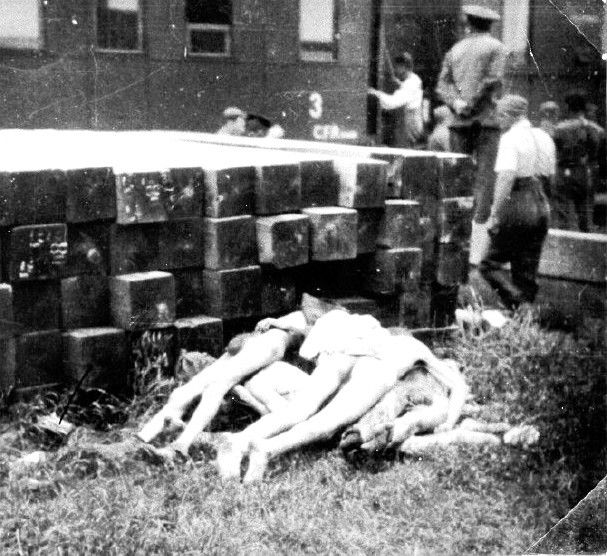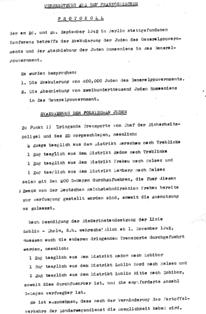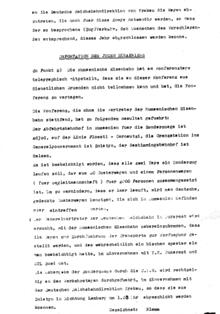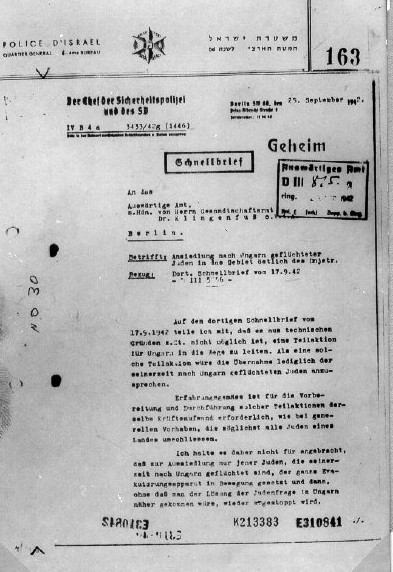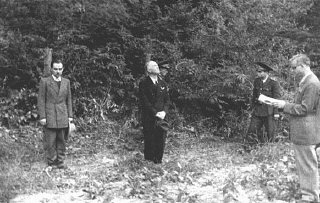Holocaust Education & Archive Research Team |
|
Occupation German Occupation of Europe Timeline
-
[The Occupied Nations]
Poland Austria Belgium Bulgaria Denmark France Germany Greece Hungary Italy Luxembourg The Netherlands Norway Romania Slovakia Soviet Union Sudetenland
| |||||||||||
The destruction of the Jews of Romania
Jewish history in Romania has been recorded as early as the 2nd century when the Roman Empire had established its rule over an area of land that was then known as Dacia. Inscriptions and coins as well as Jewish tombstones have been have been found in such places as Sarmizegetusa and Orsova. At the Congress of Berlin in 1878, which finalized Romanian independence, the great powers made the grant of civil rights to the Jews a condition of that independence in spite of opposition by the Romanian and Russian delegates. After heated debates parliament modified the article of the constitution which made citizenship conditional on Christianity, but stated that the naturalization of Jews would be carried out individually, by vote of both chambers of parliament.
However, it was only after World War I was legislation enacted to emancipate Romanian Jewry. Despite the prevalent anti-Semitism that abounded in Romania, Jews played an important role in the transformation of of the nation from a feudal system into a modern economy and were also active in the country’s cultural life. Romania was the birthplace of the Yiddish theater. It also produced many of the first chalutzim who settled in Israel.
The bias against Jews continued into the 20's and 30', student movements began against the Jews at the major universities were organized and financed by the Ministry of the Interior. Once such movement was founded by Corneliu Zelea Codreanu and called itself "The Legion of the Archangel Michael" (precursor to the Iron Guard), the legion formed terror cells and claimed responsibility for the murder of several Jews. The Legion was known for skillful propaganda, including a very capable use of spectacle. Utilizing marches, religious processions and patriotic and partisan hymns and anthems, along with volunteer work and charitable campaigns in rural areas in support of its anti-Communist, anti-Semitic, anti-liberal, and anti-parliamentary philosophy.
On Dec. 9, 1927 Legion members carried out a pogrom in Oradea Mare in Transylvania. Five synagogues were destroyed and the Torah scrolls burned in public squares, Jews were humiliated and beaten. Soon after rioting spread throughout Romania and in Cluj, eight more Synagogues were ransacked and looted.
Although strongly opposed to the legions political aims, Carol II was a successful at keeping them out of government offices, for a while, but the growing might of the Iron Guard could not be easily ignored. The Iron Guard learned to diversify and grow its organization. They opened a string of grocery stores, restaurants and repair shops, and even managed a Legion welfare organization. By 1935 there were over 4,200 groups, that grew to over 34,000 by the end of 1937. As the Iron Guard grew in importance, it also began to take stands on what it's leaders referred to as "practical issues" and formed the Corps of Legionary Workers in 1936 which built dozens of labor camps throughout region. In the 1930's Romania had the third largest Jewish population, after the Soviet Union and Poland, but the economy was strongly influenced by the spread of Nazism and soon the entire occupational structure of the Jewish community was about to collapse.
As German penetration into the Romanian economy increased, a considerable number of Romanian politicians agreed to serve German interests in exchange for directorships in German-Romanian companies, and German trade agreements with Romania always demanded the removal of Jews in the branch involved.
King Carol II now viewed the Iron Guard as a serious threat to his reign and decided something had to be done to curb their power. On February 12th 1938 he took action by suspending the democratic constitution, dissolving all political parties, and promulgating a new fascist constitution.
Corneliu Codreanu was arrested, and shortly thereafter, on November 30th, was “shot while trying to escape” in reality, he and several other members of the Iron Guard where shackled, loaded into a truck, then strangled and shot on a deserted road.
In the summer of 1940 Romania succumbed to German pressure and ceded the regions of Bessarabia, and part of Bukovina to the Soviet Union, northern Transylvania was given to Hungary, and southern Dobrudja to Bulgaria.
Anti-Semitism was now even more rampant than prior to the cessation. Jewish homes were looted, shops burned, and many synagogues desecrated and razed to the ground. Leaders of the Bucharest community were imprisoned in the community council building while worshipers were ejected from synagogues by force.
The Iron Guard never fully recovered from the loss of Corneliu Codreanu, although the legion gained power in September 1940, its charismatic leaders were gone. The new commander of the Iron Guard was Horia Sima, who along with General Antonescu formed a new government. On September 6, King Carol abdicated, and Ion Antonescu was appointed prime minister.
Antonescu established a conservative dictatorship and openly embraced the Axis powers, he declared a Nationalist-Legionary State of Romania. The members of the Iron Guard styled themselves "legionnaires" and the "legionary police" was organized on Nazi lines with the help of the S.S.
There followed a period of anti-Semitic terrorism that lasted non-stop for five months. The Legion increased the level of already extreme anti-Semitic legislation and pursued a campaign of pogroms and political assassinations.
Thousands were massacred on the streets of Iasi, and several thousand more were packed into hermetically sealed freight cars and sent on a journey nowhere...
The train travelled aimlessly for several days during which 1,400 Jews either suffocated or died of thirst, another 1,194 bodies were removed from a second follow-up train that was also sent from Iasi.
The massacre of Jews became an everyday occurrence with tens of thousands being herded into ghettos at Kishinev, and were later deported to the region between the Dniester and the Bug rivers from which the German forces had withdrawn and given control over to the Romanians.
These deportations included 118,847 Jews from Bessarabia, Bukovina, and the Dorohoi district.
On October 16, 1941, the Romanian army occupied Odessa but timed explosions set by the NKVD rocked their headquarters a few days later and sparked a frenzied killing spree against the local Jewish population.
Over 19,000 Jews were killed in the Odessa harbor, and some 30,000 others were deported to Dalnic where they were either shot, killed with explosives, or burned alive.
Transnistria had belonged to Soviet Ukraine before Romania was given control of the region by Germany in 1941. The territory was governed by Gheorghe Alexianu, who directly answered to Marshal Ion Antonescu. On August 19, 1941, a decree proclaimed his administration.
In late November 1941 most of the Jews from Bessarabia and Bukovina were herded into ghettos and camps in northern and central Transnistria. Village after village and town after town were emptied in a standard manner: Jews went to bed and after midnight they were awakened by the beating of drums in the streets.
People went outside, not knowing what was afoot. Jews were told that they must be at the railway station by 3 a.m. at the latest which meant that they had two hours to put some bundles together, lock up, and leave.
At the station they handed over their house keys and their residency papers, and were given in exchange a personal identification number. Then they were put on a train. They did some of the journey by train, the rest on foot, and crossed the Dniester on boats.
Following the Antonescu-ordered slaughter of the Jews of Odessa, the Romanian occupation authorities deported the survivors to camps in the Golta district: 54,000 to the Bogdanovka camp, 18,000 to the Akhmetchetka camp, and 8,000 to the Domanevka camp. In Bogdanovka all the Jews were shot to death, with the Romanian gendarmerie, the Ukrainian police, and Sonderkommando R, made up of Volksdeutsche, taking part.
In January and February 1942, 12,000 Ukrainian Jews were murdered in the two other camps. Another 28,000 Jews, mostly from the Ukraine, were killed by the SS and German police, with the help of local Germans in southern Transnistria.
The American Ambassador in Bucharest upon learning of the slaughter stated:
"It is becoming more and more evident with the moral support of the Germans, Antonescu is utilizing the present period for handling the Jewish problem in his own way.
I have it on good authority that Marshal Antonescu has stated that this is wartime, and a good time to settle with the Jews once and for all!
Another large-scale massacre in which the Romanian military authorities of Transnistria were implicated took place in Golta District, Ukrainian policemen and Romanian gendarmes carried out mass executions. Most of the victims were Ukrainian Jews, but thousands of Bessarabian Jews were also killed.
The massacre in Golta began on the morning of December 21, 1941. The first lot to be massacred consisted of the sick and the disabled, they were herded into horse stables, the Romanian gendarmes scattered hay on the roof and in front of the entrances, then poured gasoline. The order rang out to light the fires, and in several minutes the stables and the four to five thousand lives inside, went up in smoke.
Despite the pogrom at Iasi, the deportations from Bessarabia and Bukovina, the repeated massacres in those provinces, and the Transnistria genocide, a large segment of the Jewish population of Romania was still alive in 1942. The Jewish population of Moldavia, Walachia, and Transylvania were still alive. This did not go by unnoticed by Nazi Germany, which continued to pressure Romania and its other allies to “solve the Jewish question."
On August 17, 1942, Marshal Antonescu had given consent for the final deportations and had agreed that transports would begin from the districts of Arad, Timisoara, and Turda. Romanian officials were invited to a special conference in Berlin to discuss the details with the Foreign Office and the RSHA, they failed to attend, but general orders were issued nonetheless.
Order to the General administrator of the Romania Railway:
Meanwhile back in Berlin, the conference was held at the Ministry of Transport on the 26 and 28 of September, 1942 and was headed by Klemm of the Ministry of Transport, Stier from GEDOB (General Direction of Ostbahn) and members from the RSHA IV B 4 either Eichmann or Rolf Gunther, his deputy.
This conference was convened to discuss the deportation of 600,000 Jews from the General Government and 200,000 Romanian Jews to the General Government. A schedule was drawn up showing the deportations to the Aktion Reinhard death camps of Belzec, Sobibor and Treblinka. Despite the missing Romanian railway officials the Nazis pressed ahead with the planning of the deportations.
The planned deportation of the Romanian Jews to the death camp at Belzec on the Ploesti- Cernauti line via the border station of Sniatyn in the General Government, then passing through Lemberg (Lvov) to the Belzec death camp never materialised.
The plan was thwarted by a combination of squabbles within the Romanian administration, a protest submitted by the United States Government to the Romanian government in September 1942 and the efforts of Jewish leaders within Romania.
An inefficient Romanian bureaucracy fraught with internal and external interventions, as well as the unfavorable turn of the war were all factors that inevitably contributed to the cancellation of the plans to murder the Jews from Moldavia and Walachia. The Soviet army overran most of Transnistria in the spring of 1944 and Bessarabia was conquered in the first weeks of the summer offensive.
As Soviet troops massed on the Prut River, which separates Moldavia from Bessarabia, a group of opposition politicians, supported by King Michael, overthrew Antonescu and signed an armistice with the Soviet Union on August 23, 1944.
Between 1941 and 1944, German and Romanian authorities murdered or caused the deaths of between 150,000 and 250,000 Romanian and Ukrainian Jews in Transnistria.
At least 270,000 Romanian Jews were killed or died from mistreatment but it is important to mention that Jews were not the only minorities targeted by Romanians.
Gypsies were also affected by the Holocaust, with twenty six thousand deported, around seven thousand massacred, and another three thousand were starved to death.
Antonescu and several other officials of the Romanian wartime regime were tried in 1945 Four of the accused were executed in Romania: Ion Antonescu, Mihai Antonescu, C. Z. Vasiliu, and Gheorghe Alexianu.
In dozens of cases civil servants and high-ranking officers had death sentences commuted. However, most Romanian perpetrators were never brought to justice.
Sources:
The Final Solution by G. Reitlinger – Vallentine Mitchell &Co Ltd 1953. The Sword and the Archangel: Fascist Ideology in Romania. Ioanid, Radu Translated by Peter Heinegg. Columbia University Press, 1990. Belzec, Sobibor Treblinka by Yitzhak Arad published by Indiana University Press 1987 Minutes of the Meeting – Eichmann Trial – Wiener Library The Holocaust – by Sir Martin Gilbert, published by Collins, London 1986. The years of extermination. Saul Friedlander . First Harper Perennial 2008 The Jewish Museum of Deportation and Resistance The Romanian Jewish Community Online USHMM
Copyright: Dvidiu Lapescu & Carmelo Lisciotto H.E.A.R.T 2008
|
